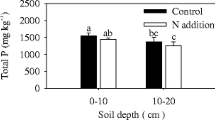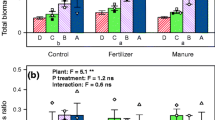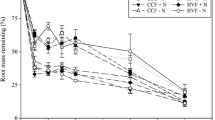Abstract
Many tropical agro-ecosystems rely on organic resources for nutrient provision. Various factors affect the nutrient release dynamics of organic resources, including application of external nutrients during their growth and their age or physiological stage at the time of harvest. Understanding relationships between organic resource management factors and the resulting nutrient release dynamics is important for optimizing nutrient recovery by crops and minimizing nutrient losses to the environment. Here, Mucuna pruriens and Lablab purpureus legumes were grown on a ‘slope’ and ‘plateau’ field, treated or not with rock phosphate, and sampled from 12 to 30 weeks after planting. These plant residues were then incubated in a sandy soil under laboratory conditions and mineral N and Olsen-extractable P dynamics were measured for 28 days. Our results showed that plant age had an impact on N, P and polyphenol contents. Application of rock phosphate only altered the P content of the legumes on the ‘plateau’ field, which had a lower soil-available P content. We also observed that mineral N dynamics of the organic resources varied between −62% of the added N released after 28 days, indicating net immobilization, and +23%, indicating net mineralization, with most organic resources showing an initial N immobilization phase. N release was negatively related to the lignin-to-N and (lignin+polyphenol)-to-N ratios of the organic resources. Lastly, we observed that the net release of Olsen P relative to the control soil varied between 0.4 and 4.9 mg kg−1 and that net P release was positively related to the P content of the organic resources. In summary, legume age was the parameter that most strongly influenced the quality of the legume residues, and consequently its N and P release dynamics, with potentially significant consequences for N and P uptake recovery and losses and, ultimately, cropping system sustainability.
Similar content being viewed by others
References
Amato M. (1982) Determination of carbon 12C and 14C in plant and soil, Soil Biol. Biochem. 15, 611–612.
Anderson J.M., Ingram J.S.I. (1993) Tropical Soil Biology and Fertility: A Handbook of Methods, CAB International, Wallingford, UK.
Cadisch G., Giller K.E. (1997) Driven by Nature. Plant Litter Quality and Decomposition, CAB International, Oxon, UK.
Cadisch G., Giller K.E. (2000) Soil organic matter management: The role of residue quality in carbon sequestration and nitrogen supply, in: Rees R.M., Ball B., Watson C., Campbell C. (Eds.), Sustainable Management of Soil Organic Matter, CAB International, Wallingford, UK, pp. 97–111.
Günther K.D., Mohme H., Rukantabula A. (1988) The mineral content of pasture fodders at Mpwapwa, Tanzania, and the influence of Ca-P supplementation and different starch and urea levels in the diet on some metabolic parameters in sheep, Giessener Beitrage zur Entwicklungsforschung Symposien 17, 255–266.
Handayanto E., Cadisch G., Giller K.E. (1995) Manipulation of quality and mineralization of tropical legume tree prunings by varying nitrogen supply, Plant Soil 176, 149–160.
Harborne J.B. (1997) Role of phenolic secondary metabolites in plants and their degradation in nature, in: Cadisch G., Giller K.E. (Eds.), Driven by Nature. Plant Litter Quality and Decomposition, CAB International, Oxon, UK, pp. 67–74.
International Institute of Tropical Agriculture (1982) Automated and semi-automated methods for soil and plant analysis, Manual series No. 7, IITA, Ibadan, Nigeria.
Lloveras J., Iglesias I. (2001) Morphological development and forage quality changes in crimson clover (Trifolium incarnatum L.), Grass Forage Sci. 56, 395–404.
Mafongoya P.L., Dzowela B.H., Nair P.K. (1997) Effect of multipurpose trees, age of cutting and drying method on pruning quality, in: Cadisch G., Giller K.E. (Eds.), Driven by Nature. Plant Litter Quality and Decomposition, CAB International, Oxon, UK, pp. 167–174.
Mero R.N., Uden P. (1997) Promising tropical grasses and legumes as feed resources in central Tanzania. I. Effect of different cutting patterns on production and nutritive value of six grasses and six legumes, Trop. Grasslands 31, 549–555.
Melillo J.M., Aber J.D., Muratore J.F. (1982) Nitrogen and lignin control of hardwood leaf litter decomposition dynamics, Ecology 63, 621–626.
Nwoke O.C., Vanlauwe B., Diels J., Sanginga N., Osonubi O. (2004) The distribution of phosphorus fractions and desorption characteristics of some soils in the moist savanna zone of West Africa, Nutr. Cycl. Agroecosys. 69, 127–141.
Nziguheba G., Merckx R., Palm C.A., Rao M.R. (2000) Organic residues affect phosphorus availability and maize yields in a Nitisol of western Kenya, Biol. Fert. Soils 32, 328–339.
Oglesby K.A., Fownes J.H. (1992) Effects of chemical composition on nitrogen mineralization from green manures of seven tropical leguminous trees, Plant Soil 143, 127–132.
Okalebo J.R., Gathua K.W., Woomer P.L. (1993) Laboratory Methods of Soil and Plant Analysis: A working Manual, Tropical Soil Biology and Fertility Programme, Nairobi, Kenya.
Ozanne P.G. (1986) Phospate nutrition of plants — a general treatise, in: Khasawneh F.E., Sample E.C., Kamprath E.J. (Eds.), The Role of Phosphorus in Agriculture, American Society of Agronomy, Madison, USA, pp. 559–589.
Palm C.A., Sanchez P.A. (1991) Nitrogen release from the leaves of some tropical legumes as affected by their lignin and polyphenolic contents, Soil Biol. Biochem. 23, 83–88.
Palm C.A., Myers R.J.K., Nandwa S.M. (1997) Combined use of organic and inorganic nutrient sources for soil fertility maintenance and replenishment, in: Buresh R.J., Sanchez P.A., Calhoun F. (Eds.), Replenishing Soil Fertility in Africa, Soil Science Society of America Special Publication Number 51, Madison, Wisconsin, USA, pp. 193–217.
Palm C.A., Gachengo C.N., Delve R.J., Cadisch G., Giller K.E. (2001) Organic inputs for soil fertility management in tropical agroecosystems: application of an organic resource database, Agr. Ecosyst. Environ. 83, 27–42.
Pypers P., Verstraete S., Cong P.T., Merckx R. (2005) Changes in mineral nitrogen, phosphorus availability and salt-extractable aluminium following the application of green manure residues in two weathered soils of South Vietnam, Soil Biol. Biochem. 37, 163–172.
SAS (1985) SAS User’s Guide: Statistics, 5 ed., SAS Institute Inc. Cary, NC, USA.
SAS (1992) The MIXED procedure. SAS Technical Report P-229: SAS/STAT Software: Changes and Enhancements, SAS Institute Inc., Cary, NC, USA, pp. 287–366.
Swain T. (1979) Tannins and lignins, in: Rosenthal G.A., Janzen D.H. (Eds.), Herbivores Their Interactions with Secondary Plant Metabolites, Academic Press, New York, USA, pp. 657–682.
Umrit G., Friesen D.K. (1994) The effect of C:P ratio of plant residues added to soils of contrasting phosphate sorption capacities on P uptake by Panicum maximum (Jacq.), Plant Soil 158, 275–285.
Vanlauwe B., Nwoke O.C., Sanginga N., Merckx R. (1996) Impact of residue quality on the C and N mineralization of leaf and root residues of three agroforestry species, Plant Soil 183, 221–231.
Vanlauwe B., Sanginga N., Merckx R. (1997) Decomposition of four leucaena and senna prunings in alley cropping systems under sub-humid tropical conditions: The process and its modifiers, Soil Biol. Biochem. 29, 131–137.
Vanlauwe B., Nwoke O.C., Diels J., Sanginga N., Carsky R.J., Deckers J., Merckx R. (2000a) Utilization of rock phosphate by crops on a representative toposequence in the Northern Guinea savanna zone of Nigeria: Response by Mucuna pruriens, Lablab purpureus, and maize, Soil Biol. Biochem. 32, 2063–2077.
Vanlauwe B., Diels J., Sanginga N., Carsky R.J., Deckers J., Merckx R. (2000b) Utilization of rock phosphate by crops on a representative toposequence in the Northern Guinea savanna zone of Nigeria: Response by maize to previous herbaceous legume cropping and rock phospate treatments, Soil Biol. Biochem. 32, 2079–2090.
Vanlauwe B., Aihou K., Aman S., Iwuafor E.N.O., Tossah B.K., Diels J., Sanginga N., Merckx R., Deckers S. (2001) Maize yield as affected by organic inputs and urea in the West-African moist savanna, Agron. J. 93, 1191–1199.
Vanlauwe B., Diels J., Sanginga N., Merckx R. (2002) Integrated plant nutrient management in sub-Saharan Africa: From Concept to Practice, CABI, Wallingford, UK.
Vanlauwe B., Bationo A., Carsky R.J., Diels J., Sanginga N., Schulz S. (2003) Enhancing the contribution of legumes and biological nitrogen fixation in cropping systems: experiences from West Africa, in: Waddington S.R. (Ed.), Grain Legumes and Green Manures for Soil Fertility in Southern Africa: Taking Stock of Progress, Soil Fertility and Policy Network for Maize-based Cropping Systems in Southern Africa, Harare, Zimbabwe, pp. 3–13.
Van Soest P.J., Wine R.H. (1968) Determination of lignin and cellulose in acid-detergent fiber with permanganate, J. Assoc. Off. Agr. Chem. 51, 780–785.
Versteeg M.N., Amadji F., Eteka A., Gogan A., Koudokpon V. (1998) Farmers’ adoptability of Mucuna fallowing and agroforestry technologies in the coastal savanna of Benin, Agr. Syst. 56, 269–287.
Author information
Authors and Affiliations
Corresponding author
About this article
Cite this article
Vanlauwe, B., Idrissa, A., Diels, J. et al. Plant age and rock phosphate effects on the organic resource quality of herbaceous legume residues and their N and P release dynamics. Agron. Sustain. Dev. 28, 429–437 (2008). https://doi.org/10.1051/agro:2008015
Accepted:
Issue Date:
DOI: https://doi.org/10.1051/agro:2008015




